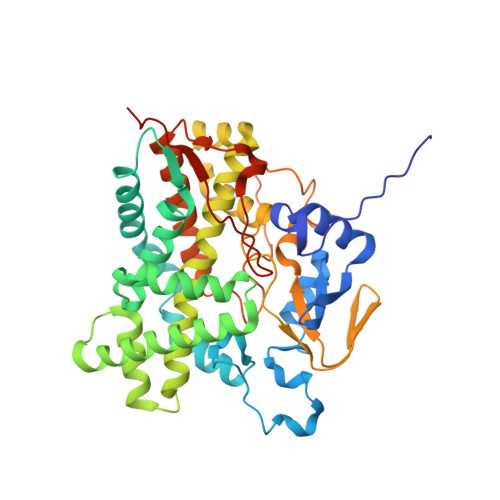A single mutation at the ferredoxin binding site of p450 vdh enables efficient biocatalytic production of 25-hydroxyvitamin d3.
Yasutake, Y., Nishioka, T., Imoto, N., Tamura, T.(2013) Chembiochem 14: 2284-2291
- PubMed: 24115473
- DOI: https://doi.org/10.1002/cbic.201300386
- Primary Citation of Related Structures:
3VRM - PubMed Abstract:
Vitamin D3 hydroxylase (Vdh) from Pseudonocardia autotrophica is a cytochrome P450 monooxygenase that catalyzes the two-step hydroxylation of vitamin D3 (VD3 ) to produce 25-hydroxyvitamin D3 (25(OH)VD3 ) and 1¦Á,25-dihydroxyvitamin D3 (1¦Á,25(OH)2 VD3 ). These hydroxylated forms of VD3 are useful as pharmaceuticals for the treatment of conditions associated with VD3 deficiency and VD3 metabolic disorder. Herein, we describe the creation of a highly active T107A mutant of Vdh by engineering the putative ferredoxin-binding site. Crystallographic and kinetic analyses indicate that the T107A mutation results in conformational change from an open to a closed state, thereby increasing the binding affinity with ferredoxin. We also report the efficient biocatalytic synthesis of 25(OH)VD3 , a promising intermediate for the synthesis of various hydroxylated VD3 derivatives, by using nisin-treated Rhodococcus erythropolis cells containing VdhT107A . The gene-expression cassette encoding Bacillus megaterium glucose dehydrogenase-IV was inserted into the R. erythropolis chromosome and expressed to avoid exhaustion of NADH in a cytoplasm during bioconversion. As a result, approximately 573 ¦̀g mL(-1) 25(OH)VD3 was successfully produced by a 2 h bioconversion.
Organizational Affiliation:
Bioproduction Research Institute, National Institute of Advanced Industrial Science and Technology (AIST), 2-17-2-1, Tsukisamu-higashi, Toyohira-ku, Sapporo 062-8517 (Japan).
















